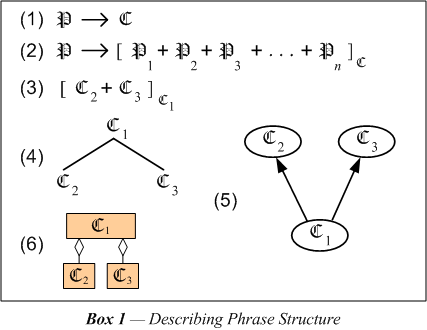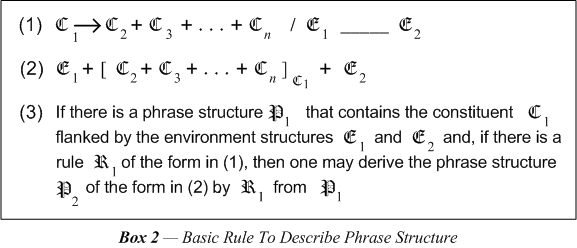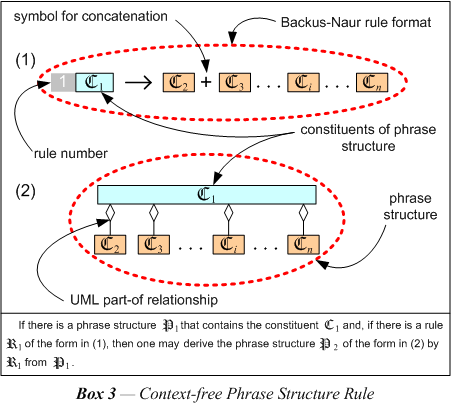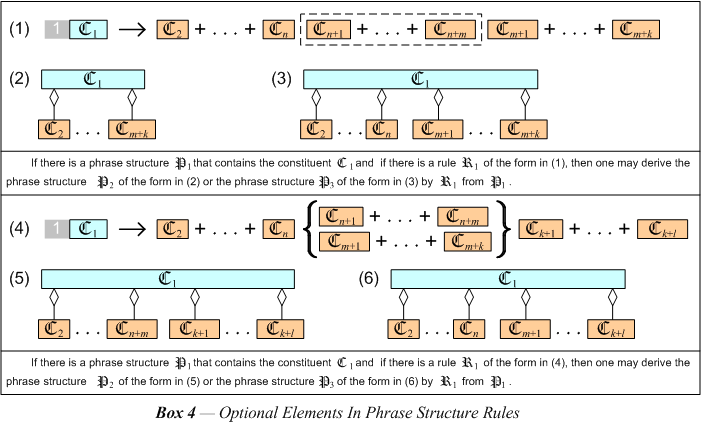A. Phrase structure rules.
The idea of using a generative approach (GT grammar) for describing syntax originated with Noam Chomsky in 1957 (Chomsky, 1957).
The mathematician may use this approach in the componential analysis of any language.
The present author has demonstrated in another work the possibility of using a GT grammar to describe some of the various calculi of logic (Despain, 2004).
The linguist may relate the descriptions of the calculi to each other by the use of complex symbols and transformations.
When Chomsky first developed GT grammar, it was because he needed a suitable tool to describe the sentences of a natural language like English.
The analyst uses it as a tool always keeping in mind that it is the structure of the language at hand that should constrain the form of the rules of the GT grammar of that language.
In this section we introduce enough of a GT grammar to describe the general structure of a personal name in English.
A calculus in the sense of a “language of logic” comprises two kinds of rules: 1) rules of formation and 2) rules of transformation.
The rules of formation tell what the primitive expressions are that can stand on their own as axiomatic.
The rules of transformation tell what expressions can be derived directly from those primitive expressions.
The GT linguist defines a phrase structure ( ) as an ordered sequence of constituents (
) as an ordered sequence of constituents ( ).
Box one contains two formation rules in (1) and (2) of the calculus that describes the linguistic structure that the PS rules of the grammar must characterize.
These are rules of a metalanguage telling us first of all how to represent phrase structure.
).
Box one contains two formation rules in (1) and (2) of the calculus that describes the linguistic structure that the PS rules of the grammar must characterize.
These are rules of a metalanguage telling us first of all how to represent phrase structure.

In words the first rule (1) states that a phrase structure may be defined simply as a single constituent.
The second formation rule (2) states that a phrase structure may consist of a labelled bracketing of a phrase structure of any length having any number of phrase structures as parts.
In accord with the second rule, suppose that (3) is the phrase structure of some fragment of English.
The structure is describing the parts of constituent number 1 (the label on the bracket), which parts consist in the two constituents numbered 2 and 3.
These latter two constituents may themselves be represented with labelled brackets, which would then be embedded within this example.
Embedded structures in a linear string may become difficult to conceptualize and so it is more convenient to utilize tree graphs, i.e., tree diagrams for delineating phrase structure.
The diagram (4) is a tree graph where the concept of rewrite is represented by multiple more or less vertically directed edges.
It is particularly the large structures generated by recursiveness (in rules like the first rule for the phrase structure of a personal name given below) that motivate the use of tree diagrams for clarity.
Sometimes it is appropriate to use the form in (5).
The Unified Modelling Language (UML) used by computer systems designers prescribes the format given in (6).
The diamond-headed arrow is their convention for connecting objects in the “part-of” relationship.
Now, the way to describe the phrase structure of a particular linguistic expression is by means of a phrase structure rule ( ).
This kind of rule has the form in (1) in box 2.
The structure generated by the PS-rule in (1) is characterized in (2).
).
This kind of rule has the form in (1) in box 2.
The structure generated by the PS-rule in (1) is characterized in (2).
GT grammar, which is the metalanguage describing linguistic theory, has a replacement rule for interpreting the phrase structure rule.
This is a rule of inference, i.e., a transformation of the metalanguage, whose import is in given (3).
The PS-rules have also suffered changes in convention imposed by computer systems designers.
In this case we may translate the rules into what is called Backus-Naur form.
This form is almost identical, but cannot take advantage of the structural environment.
The constituents are obliged to be defined free of their context.
Box 4 describes two conventions for reducing the number of rules through abbreviation.
When two rules are exactly the same, except that one has one or more contiguous constituents in addition to those of the other, these optional additions may be shown either in parens or by means of a dashed line.
When there are multiple alternative constituents at some point, these alternatives are written in parallel within curly brackets.
 ) as an ordered sequence of constituents (
) as an ordered sequence of constituents ( ).
Box one contains two formation rules in (1) and (2) of the calculus that describes the linguistic structure that the PS rules of the grammar must characterize.
These are rules of a metalanguage telling us first of all how to represent phrase structure.
).
Box one contains two formation rules in (1) and (2) of the calculus that describes the linguistic structure that the PS rules of the grammar must characterize.
These are rules of a metalanguage telling us first of all how to represent phrase structure.

 ).
This kind of rule has the form in (1) in box 2.
The structure generated by the PS-rule in (1) is characterized in (2).
).
This kind of rule has the form in (1) in box 2.
The structure generated by the PS-rule in (1) is characterized in (2).



